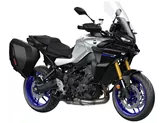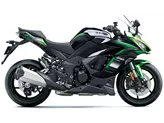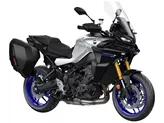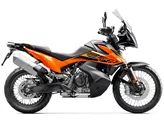Kawasaki Ninja 1000SX 2020 vs. Yamaha Tracer 9 GT 2021

Kawasaki Ninja 1000SX 2020

Yamaha Tracer 9 GT 2021
Overview - Kawasaki Ninja 1000SX 2020 vs Yamaha Tracer 9 GT 2021
The Kawasaki Ninja 1000SX 2020 and the Yamaha Tracer 9 GT 2021 are both sport touring motorcycles that offer a combination of sporty performance and touring comfort. However, there are several key differences between the two models.
In terms of engine performance, the Kawasaki Ninja 1000SX 2020 comes out on top with its 142 horsepower engine, compared to the Yamaha Tracer 9 GT 2021's 119 horsepower engine. The Kawasaki also has a higher torque rating at 111 Nm, compared to the Yamaha's 93 Nm. Both bikes have in-line engines with four strokes, but the Kawasaki has four cylinders while the Yamaha has three. The Kawasaki also has a larger displacement at 1043 ccm, compared to the Yamaha's 890 ccm.
When it comes to suspension, both bikes feature upside-down telescopic forks at the front and monoshock absorbers at the rear. The Yamaha Tracer 9 GT 2021 has slightly longer travel in both the front and rear suspension, offering a more comfortable ride over rough surfaces. Additionally, the Yamaha's rear suspension only has preload adjustment, while the Kawasaki's rear suspension offers compression, preload, and rebound adjustment.

Kawasaki Ninja 1000SX 2020
In terms of chassis, both bikes feature aluminum frames, providing a good balance of rigidity and weight. The Kawasaki Ninja 1000SX 2020 has slightly larger front brakes with a diameter of 300 mm, compared to the Yamaha Tracer 9 GT 2021's 298 mm front brakes. Both bikes offer advanced rider assistance systems such as ABS, cornering ABS, ride by wire, quickshifter, and traction control.
In terms of dimensions and weights, the Yamaha Tracer 9 GT 2021 has a longer wheelbase at 1500 mm, compared to the Kawasaki Ninja 1000SX 2020's 1440 mm wheelbase. The Yamaha also has a slightly lower seat height at 810 mm, compared to the Kawasaki's 834.98 mm seat height. The Yamaha is also lighter, with a kerb weight of 220 kg, compared to the Kawasaki's 235 kg weight. Both bikes have a fuel tank capacity of 19 liters.
In terms of equipment, both bikes offer LED headlights and TFT displays. The Kawasaki Ninja 1000SX 2020 also has LED daytime running lights and a windscreen that is adjustable. The Yamaha Tracer 9 GT 2021 offers additional features such as heated grips, a case system, cornering lights, and anti-wheelie assistance.

Yamaha Tracer 9 GT 2021
In terms of strengths, the Kawasaki Ninja 1000SX 2020 has a refined and powerful engine, balanced handling, comfortable chassis, and modern looks. It also comes with cruise control as a standard feature. The Yamaha Tracer 9 GT 2021, on the other hand, offers a great standard equipment package in its GT variant, with a powerful engine and easy handling. It also has a comprehensive electronics package and great pillion comfort, as well as a long range.
In terms of weaknesses, the Kawasaki Ninja 1000SX 2020 has a windshield that can only be adjusted with both hands, which can be inconvenient. The Yamaha Tracer 9 GT 2021 has a poorly readable and illogical display, as well as a somewhat rough clutch and moderate responsiveness.
Overall, both the Kawasaki Ninja 1000SX 2020 and the Yamaha Tracer 9 GT 2021 offer a combination of sporty performance and touring comfort. The choice between the two will ultimately depend on individual preferences and priorities, such as engine power, handling, and specific features and equipment.
Technical Specifications Kawasaki Ninja 1000SX 2020 compared to Yamaha Tracer 9 GT 2021
Pros and Cons in comparison
Pros and Cons in comparison
Kawasaki Ninja 1000SX 2020

The Kawasaki Ninja 1000SX is more evolution than revolution - but what is the point of reinventing everything in a balanced sports tourer? But the new name is definitely justified, with the many new features made possible by the Ride-by-Wire system, among others, the sports tourer is absolutely up to date. Cornering ABS, modern traction control and riding modes provide safety and adjustment options to personal preferences, the shift assistant favours sport as well as touring. What's more, the price is hot (at least in Austria)!
Yamaha Tracer 9 GT 2021

Yamaha impressively proves how wonderfully emotional a practical motorbike can be. Again and again you laugh mischievously into your helmet when you let the husky three-cylinder off the leash. An all-round successful motorbike that can replace half a motorbike garage. Unfortunately, the attempt with the unconventional display was a failure. It is impractical and difficult to read.
Price Comparison Avarage Market Price Kawasaki Ninja 1000SX vs Yamaha Tracer 9 GT
There are a few key differences between a Kawasaki Ninja 1000SX 2020 and a Yamaha Tracer 9 GT 2021. In terms of price, the actual average price of a Yamaha Tracer 9 GT 2021 is about 12% higher. Compared to Yamaha Tracer 9 GT 2021 there are less Kawasaki Ninja 1000SX 2020 bikes available on the 1000PS.de Marketplace, specifically 10 compared to 25. It takes less time to sell a Kawasaki Ninja 1000SX with 83 days compared to 84 days for a Yamaha Tracer 9 GT. Since model year 2020 1000PS.de editors have written 13 reviews for the Kawasaki Ninja 1000SX and 17 reviews for the Yamaha Tracer 9 GT since model year 2021. The first review for the Kawasaki Ninja 1000SX was published on 11/5/2019 and now has more than 40,500 views. This compares to more than 61,200 views for the first review on Yamaha Tracer 9 GT published on 11/8/2020.























